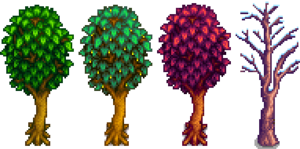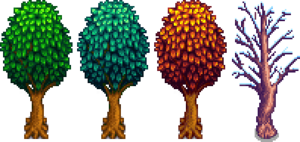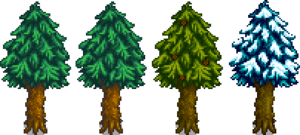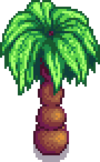Difference between revisions of "Trees"
Margotbean (talk | contribs) (wording change) |
Margotbean (talk | contribs) |
| (One intermediate revision by one other user not shown) | |
(No difference)
| |
Revision as of 17:37, 12 July 2018
- This article is about non-fruit trees. For Fruit Trees, see the Fruit Trees page.
Trees that do not yield fruit are of two types: common, and special. Fully grown common trees yield resin, tar, or syrup when tapped with a Tapper, or wood and sap when felled by an axe. After Foraging Level 1, felling common trees also produces some of the tree's own seed, which can then be planted on The Farm. Common trees that grow outside of the farm will grow back without the need to plant a seed, unless you leave the stump. Special trees have their own unique characteristics.
Common Trees can be planted in the Greenhouse.
Common Trees
Three varieties of common trees grow on The Farm and within Stardew Valley. Their sap may be used to produce Maple Syrup, Pine Tar, or Oak Resin via a Tapper, and their Wood has many uses, including Crafting and building construction/upgrades.
Trees can be felled by chopping them repeatedly with an axe. Trees always fall left or right on the opposite side from the player (if applicable), and produce wood or seeds in that direction. When chopped from above or below, the tree may fall in either direction. If the tree falls into or near water, the items it drops may disappear into the water. Rings like the Magnet Ring are very useful when chopping trees, as they allow the player to pick up items within a wider radius, reducing the need to cut obstacles to get to the fallen wood. Once cut down, trees don't regrow on the farm even if you leave the stump, however seeds can spawn around stumps.
Once per day, each tree or seed has a 20% chance of growing if it's not already fully-grown, and the season isn't winter (or it's in the Greenhouse). The tree won't reach full growth if there's a fully-grown non-fruit tree within its 3×3 grid, though it'll still grow to the sapling stage (Stage 4). The median growth time to maturity should be about 18 days, though actual growth times can vary considerably. Statistically, less than 10% of seeds take more than 31 days to reach maturity and less than 1% take more than 46 days.
The area around a tree can be paved without ill effects. Common trees can also be planted next to water and other permanent features of the landscape, next to the greenhouse, or next to tilled soil with crops and still grow to full maturity.
Trees in Town cannot be interacted with. Common trees in Cindersap Forest, The Mountain, Railroad, Bus Stop and Backwoods can all be chopped down or tapped. If such trees are chopped down, and the stumps removed, they will respawn as a Stage 3 sapling (20% chance each night) and grow to maturity as normal after that. While these trees will not grow to maturity in winter they will still spawn as a Stage 3 sapling in winter.
Tree seeds can be planted in the hoed spot left from digging up an Artifact Spot, and will act the same as a tree planted on the farm.
Once fully grown, each tree has a ≈5% chance of producing a seed once per day. Shaking the tree will drop its seed, if it has one.
Unlike Fruit Trees which produce Coal for 3-4 days after being hit by lightning, common trees hit by lightning are destroyed, leaving only a stump (and some wood or sap) behind.
Maple Tree
Maple Trees grow from Maple Seeds. When tapped, they yield Maple Syrup every 7-8 days. Maple trees have a chance to drop a Hazelnut during the last 2 weeks of Fall.
Maple Syrup is the most profitable of the 3 types of common tree syrup.
| Maple Tree | ||||||
|---|---|---|---|---|---|---|
| Seed | Stage 1 | Stage 2 | Stage 3 | Stage 4 | Stage 5 - Spring, Summer, Fall, Winter | Tapper Product |
 |
 |
 |
 |
 |
||
Oak Tree
Oak Trees grow from Acorns. When tapped, they yield Oak Resin every 6-7 days.
| Oak Tree | ||||||
|---|---|---|---|---|---|---|
| Seed | Stage 1 | Stage 2 | Stage 3 | Stage 4 | Stage 5 - Spring, Summer, Fall, Winter | Tapper Product |
 |
 |
 |
 |
|||
Pine Tree
Pine Trees grow from Pine Cones. When tapped, they yield Pine Tar every 4-5 days.
| Pine Tree | ||||||
|---|---|---|---|---|---|---|
| Seed | Stage 1 | Stage 2 | Stage 3 | Stage 4 | Stage 5 - Spring, Summer, Fall, Winter | Tapper Product |
 |
 |
 |
 |
 |
||
Special Trees
Special trees have uncommon properties and yields.
Mushroom Tree
Mushroom Trees are a rare occurrence on the farm. Each Fall, there is a chance for a fully grown common tree to change into a Mushroom Tree during the night. Mushroom Trees cannot be planted, but they do spread like other trees, and yield Red or Purple Mushrooms when chopped down. They can be tapped and will yield mushrooms over time.
| Mushroom Tree | |||||
|---|---|---|---|---|---|
| Stage 1 | Stage 2 | Stage 3 | Stage 4 | Stage 5 | Tapper Product |
 |
 |
 |
100px | ||
Palm Tree
Palm Trees are found only in The Calico Desert. They do not drop seeds, but may occasionally drop a Coconut when chopped down or shaken. They cannot be tapped.
| Palm Tree | ||
|---|---|---|
| Stage 1 | Stage 2 | Stage 3 |
 |
 |
 |
Bugs
- Normally a Maple, Oak, or Pine Tree can be planted only on The Farm, or in select spots of tillable soil outside the farm. However, an Acorn, Maple Seed, or Pine Cone can be planted in the tilled tile left by digging up an Artifact Spot, no matter where it occurs.
- As soon as you level up in Foraging Skill, all common trees stop dropping seeds when shaken or chopped down, and their seeds disappear when harvesting them with a tool. This lasts the rest of the day, but is fixed after sleeping and waking up the next day.
Trivia
Watering a Stage 2 or 3 tree makes the same sound as striking it with a Scythe.
| Trees | |
|---|---|
| Trees | Green Rain Trees • Mahogany Tree • Maple Tree • Mushroom Tree • Mystic Tree • Oak Tree • Palm Tree • Pine Tree |
| Fruit Trees | Apple Tree • Apricot Tree • Banana Tree • Cherry Tree • Mango Tree • Orange Tree • Peach Tree • Pomegranate Tree |
| Seeds | Acorn • Mahogany Seed • Maple Seed • Mossy Seed • Mushroom Tree Seed • Pine Cone • Mystic Tree Seed |
| Fruit | Apple • Apricot • Banana • Cherry • Mango • Orange • Peach • Pomegranate |
| Misc | Large Log • Large Stump • Tea Bush |